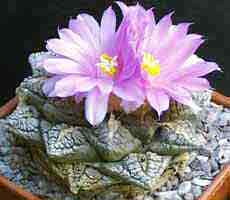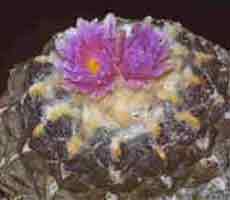|
Original Publication
Mammillaria fissurata Engelmann, (1856)
Proc. Amer. Acad. 3: 270.
Transferred to Ariocarpus by Schumann in
1894.
Ariocarpus fissuratus Schumann K. (1894) in
Engler & Prantl, Nat. Pflanzenfam. 3, 6a:195.
|
Plant
grey-green, becoming yellowish with age, even with or rising
slightly above ground level, subglobose, flattened or sometimes
rounded on top, 1-10cm high, 5-10 (occasionally up to 15)cm in
diam.; tubercles laterally divergent, crowded, basally compressed,
usually rounded at the apices, flattened or slightly convex
adaxially, with numerous adaxial fissures, 10-20mm long, 15-25mm
broad, usually slightly broader than long; areoles central
longitudinal grooves on the adaxial surfaces of the tubercles,
woolly, 3-4mm wide, 10-15mm long; flowers 2.5-4.5cm in diam.,
1.5-3.5cm long; outer perianth parts light magenta, sometimes
becoming whitish, 1.2-3 5cm long, 5-9mm broad; inner perianth parts
light magenta, 1.3-3.4cm long, 4-10mm broad; pistil sometimes not
exserted but often 1-3mm above the stamens; style 1.6-2.1cm long;
stigmas 5-10. 1.2-5 mm long; fruit whitish or greenish, 5-15mm
long, 2-6mm in diam.
|
|
 Ariocarpus fissuratus, a typical plant from
West Texas Ariocarpus fissuratus, a typical plant from
West Texas
|
|
|

Ariocarpus
fissuratus 'intermedius' from Cuatrocienagas,
Coahuila,
|
|
From the western side of the Big Bend
Region, and eastwards along the Rio Grande to the confluence with
the Pecos (type locality) and beyond almost to the Atlantic coast,
also in parts of central northern Coahuila. A much larger growing,
more hemispherical plant is found in southern Coahuila near Parras,
westwards as far as Nazas in Durango and southwards into northern
Zacatecas, this was described as A. lloydii. (Rose 1911) and
later as A. fissuratus
var. lloydii.. A form
intermediate between the two, is found between Cuatrocienegas
and Estacion Marte in central Coahuila and has been named A. intermedius.. A. loydii
and A. intermedius are now reduced to synonymy under A.
fissuratus as part of a North - South cline. A.
fissuratus is found on fragmented limestone hillsides and flats in
compacted sandyclay soils at altitudes of up to 1200m. A
fourth variety, A. f. var. hintonii, which grows much
further south in northern San Luis Potosi, is now considered to be
a sub-species of A. bravoanus.
|
|
Ariocarpus fissuratus is easily cultivated in
well-drained calcareous mineral soil. The more southerly plants
will take progressively more water than the more northerly
variants. In cultivation in the UK they flower from late August to
mid-October depending on local conditions.
Field Numbers
A
full listing of all associated field data can be found on the field number reference pages.
|
|

Ariocarpus fissuratus
'lloydii', the largest growing form of the
species
|
|